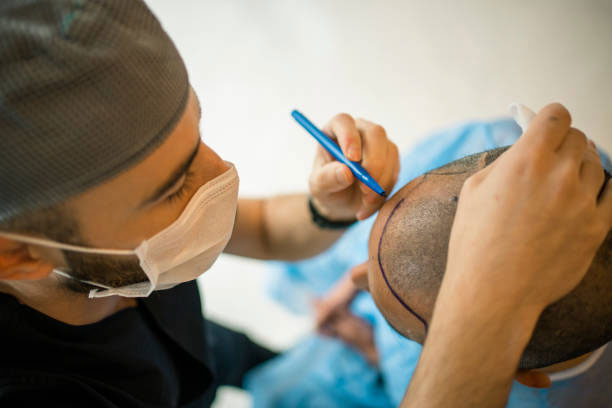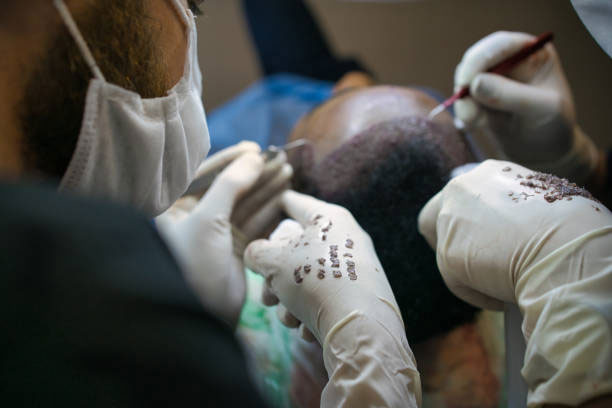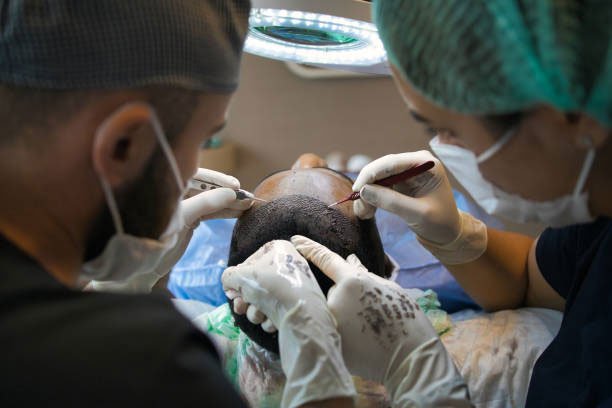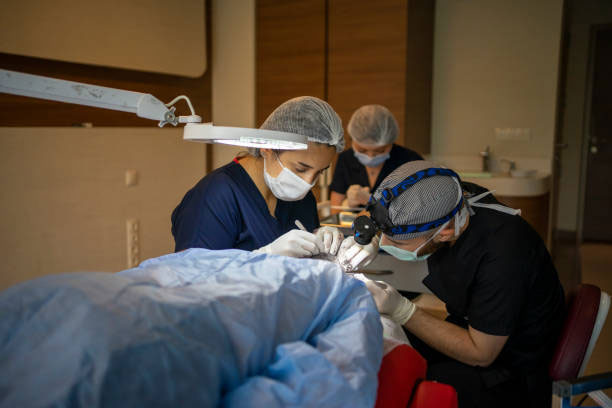HAIR TRANSPLANTATION
WHAT IS HAIR TRANSPLANT?
Hair transplantation is a natural and permanent solution to the problem of baldness or hair thinning in people suffering from hair loss. Hair transplantation is an important method that can eliminate the psychological, sociological and aesthetic negative consequences of hair loss or thinning hair in men and women.
Hair transplantation is a cosmetic surgical treatment in which microsurgical instruments can be used to achieve the most natural results possible, thanks to the developing technology and techniques for solving the problem of alopecia, i.e. hair loss that has more than one cause.
Hair transplantation, in its simplest sense, is the transfer of healthy hair follicles taken from the donor area to areas where the hair follicles are thin or where the hair follicles are inactive, by microsurgical methods. In hair transplantation, the healthy hair follicles resistant to loss are transplanted from the patient's neck area into the canals opened in the thinning or completely lost areas. The goal of hair transplantation is to naturally achieve a permanent hairy appearance that is not visible in the head area.

WHAT IS HAIR TRANSPLANT TREATMENT, HOW IS IT PERFORMED?
With the development of modern medicine and the emergence of new treatment methods and techniques in the field of aesthetics, hair transplantation treatment is coming to the forefront. Convenient and reliable application of hair transplantation methods can prevent both psychological and aesthetic problems of patients with hair loss.

In hair transplantation, hair follicles are usually taken from the nape of the neck and transplanted to the desired location. These harvested hair follicles are called grafts. Healthy hair follicles are located in the neck or temple area of the person. In some cases, hair follicles from other areas containing hair, such as the arms or the chest wall of the person, can also be transplanted into the bald area. The duration of the application depends on the width of the area to be transplanted and the method used. Depending on the method used and the width of the area to be transplanted, hair transplantation may require a single session or several sessions between 6 and 8 hours.

In hair transplantation, the procedure is performed under local anesthesia with sedation. While sedation is not mandatory, it is intended to prevent the person from experiencing pain or suffering during the procedure and depends on the person's preferences. After the hair transplant procedure, the person is discharged with a special bandage on their head. Although it is rare, pain is managed with painkillers. After hair transplantation, depending on the method used, 1 to 3 days of rest at home is prescribed. After this time you can return to work or social life with your head covered. The first dressing and washing are performed at the treatment center. How many days after the operation the first dressing and washing are done depends on the method used in the application and ranges from 2 to 5 days.
WHAT IS THE MOST IMPORTANT ELEMENT IN HAIR TRANSPLANT?
Hair transplantation is a serious surgical application as well as a cosmetic application. In order to minimize the risk of complications in hair transplantation, it is very important to do it in a hospital setting. It is very important for hair transplantation to be performed by well-trained and experienced specialist physicians in order to obtain the best results. For a successful hair transplant operation, the transplanted hair follicles must "hold" quickly in the area where they are placed. The success rate of hair transplantation is quite high if it is applied in a well-equipped hospital environment, with the right technique and by a specialist physician. For a natural appearance, it is very important that the grafts are planted at the right distance, at the right angle and at the right density in the area to be transplanted.

WHO IS SUITABLE FOR HAIR TRANSPLANT?
Hair transplant treatment is the method most commonly used today by people with hair loss problems. Today, 50 percent of men over the age of 50 suffer from hair loss. Hair loss is not only a problem of men. As with men, many women also suffer from hair loss or thinning hair as a result of male pattern hair loss. 80% of hair loss in women is male pattern hair loss, known as androgenetic alopecia. Hair loss can cause psychological, sociological and aesthetic problems, which is why many people request hair transplantation.
In hair transplantation, according to the classification of hair loss, it can be said that anyone who has enough hair follicles in the donor area is a suitable candidate for hair transplantation. In other words, the expert decides whether the candidate is suitable for this procedure or not. The patient should not have chronic diseases such as heart or kidney diseases. In case of blood clotting disorders (e.g. hemophilia, where blood does not clot properly), transplantation cannot be performed. However, there should be no significant skin disease at the site where the hair is harvested or at the site that is to be transplanted.
DOES THE TRANSPLANTED HAIR FALL OUT AFTER THE TRANSPLANTATION? DOES THE PERSON NEED TO HAVE A HAIR TRANSPLANT AGAIN?
The hairs transplanted during hair transplantation fall out within a few weeks after transplantation; however, this is to be expected. After 3-4 months, the hair that falls out is replaced with permanent hair. The new hair follicles that become stable after this temporary loss retain their character and do not fall out. However, the original hair in the same area may continue to fall out over time, and in this case, depending on the decrease in hair density, a new hair transplant may be scheduled in the future.
In some cases, hair loss may continue progressively after surgery. If this results in an unnatural appearance, another hair transplant may be required in the future.
AM I A GOOD CANDIDATE FOR HAIR TRANSPLANT?
The suitable candidate for the hair transplant must;
- have a complete physical development.
- not have a physiological disease that prevents hair transplantation.
- have sufficient number of hair follicles in the donor area and in appropriate structure.
- have a suitable space where hair follicles can be transplanted in the area to be transplanted.
Hair transplantation is successfully performed not only for male pattern hair loss, but also for local cavities that may be caused by various diseases, scars, burn scars, surgical sutures.
Hair transplantation is also successfully applied to women with male pattern hair loss. Transplantation without shaving can also be performed depending on the size of the bald spot, especially in women with hair loss.

HAIR TRANSPLANT IN MEN
Thanks to the developing technology, hair transplantation offers much easier and practical solutions to those who suffer from hair loss. With the modern methods of hair transplantation, it is now possible to get the desired lush and voluminous hair faster and effortlessly. With hair transplant treatment, it is much easier today to get rid of the problem of baldness, which is a common problem in both men and women. According to statistics, people feel happier after hair transplantation.
Hair transplantation is the most permanent and practical method of restoring hair follicles lost in baldness. During hair transplantation, several bundles of follicles, called follicular units, are transplanted from the donor area, that is, from the nape of the neck behind the two ears, into the bald area. Contrary to popular belief, hair transplantation is a complicated procedure, because it is important that the transplanted hair looks natural and the donor area is not damaged, which affects the density and appearance of the hair growing after the transplant. For this reason, it should be performed under the control of a team of experts and doctors.
WHAT IS THE MALE PATTERN HAIR LOSS IN WOMEN?
Hair loss in women can be caused by genetic factors, hormonal reasons, pregnancy or many other reasons. Hair loss in women can negatively affect women for many reasons. Male pattern hair loss, which is the main type of hair loss in women, has a greater impact than in men. Hair loss, called alopecia, can have a negative impact on women’s quality of life and mental health.
There are several types of hair loss in women. Medical literature distinguishes three types of hair loss in women: Female pattern hair loss, male pattern hair loss, and regional hair loss. Male pattern hair loss is referred to in medical terminology as androgenetic alopecia. Although this hair loss mostly occurs in men, it can also be observed in women. This hair loss, called male pattern hair loss, accounts for 80% of baldness and permanent hair loss in women. The causes of male hair loss in women can be investigated and treated if necessary, or hair transplantation methods are used.
WHAT IS THE REASON OF MALE PATTERN HAIR LOSS IN WOMEN?
There are many reasons for male pattern hair loss in women. Medical reasons, drug use, physical or emotional stress can cause male pattern hair loss in women. Genetic causes are the main cause of male pattern hair loss, called androgenic alopecia, which also occurs in women. Hormonal imbalances are also one of the main causes of male pattern hair loss in women. A family genetic predisposition is a common cause. However, the main cause of male pattern hair loss in women is the excessive secretion of the hormone androgen. Testosterone and dihydrotestosterone (DHT), which belong to the androgen hormones, have a negative effect on the hair follicles, causing them first to weaken and then to fall out.
IS THE TRANSPLANT METHOD DIFFERENT FOR FEMALE AND MALE HAIR LOSS?
The same hair transplantation techniques used for men are also used for male pattern hair loss in women. However, there may be some differences in the treatment of male and female hair loss such as the places where the hair follicles to be transplanted are harvested. The area where the hair follicles to be transplanted are harvested is different in men and women. For example, in men, the neck is used as the donor area because it is not affected by the dihydrotestosterone hormone and the hair is protected. Since hair loss in women is observed on the entire hairy surface of the head, the nape of the neck cannot be used as a donor area.
In hair loss in women, even if it is male pattern hair loss, the frontal hairline is preserved differently than in men, because hair loss is less, and baldness does not generally occur. Hair loss in women manifests itself in the form of thinning hair.
Hair transplantation with the FUE method is the best treatment when women have lost their hair after male pattern hair loss.
WHAT ARE THE RISKS OF WRONG HAIR TRANSPLANTATION?
Because hair transplantation is a surgical procedure, it can carry significant risks if not performed under proper conditions. If hair transplantation is performed by an experienced plastic surgeon in a well-equipped clinic with hygienic conditions, the risk of complications is minimal. Hair transplantation, which is a lengthy process, may require multiple transplants over a 1-2 year period depending on the degree of baldness. Although rare, complications such as unwanted infections and significant scarring can occur. After surgery, bruising and swelling may occur, and pain sensation and discomfort can be relieved with pain medications.
